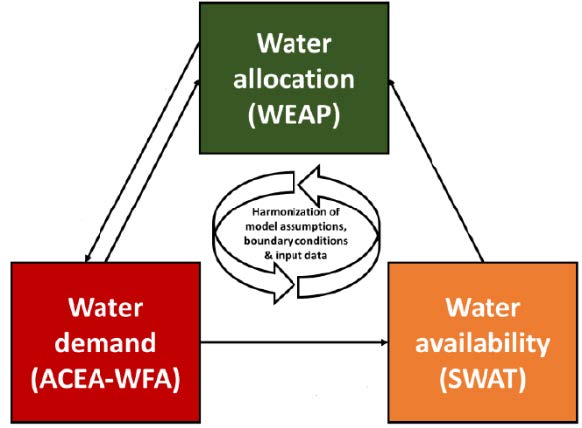The Syr Darya basin in Central Asia is a critical area of study for water management due to its complex environmental and geopolitical challenges. The ongoing environmental catastrophe surrounding the Aral Sea, the Syr Darya’s final destination, highlights the severe consequences of unsustainable water use practices. Additionally, transboundary conflicts over water resources in this region underscore the inadequacies in the current water allocation practices. The existing decision-making frameworks for water management in the Syr Darya basin lack a comprehensive understanding of the historical drivers of water consumption and over-allocation. Moreover, there is insufficient analysis of how these factors might evolve under future climate scenarios and socioeconomic developments. Addressing these gaps is crucial for developing management and adaptive measures, which can be achieved through an integrated modelling approach (Wagner et al., 2023) that analyses availability, demand, and allocation (Touch et al., 2020).
This research aims to develop an integrated modelling system as a technical solution for transboundary water management in the Syr Darya basin. The system will comprise three key components: water availability, demand, and allocation. The first two components will establish the boundary conditions for the water allocation model, forming a comprehensive foundation for understanding the basin's water balance.

Figure: Conceptual diagram of the integrated modelling system
Integrating models is a complex task. Since water availability, demand, and allocation are interconnected, the three models will partially overlap in the aspects they cover. Additionally, they may differ in their definitions, assumptions, and temporal and spatial resolutions. This necessitates a clear and transparent strategy for exchanging information between models. Deliberate decisions are made about which data to exchange, with careful consideration of potential re-interpretation, aggregation, or disaggregation. This ensures consistency and enables models and their corresponding data to interoperate on both spatial and temporal scales (Siad, 2019). During the integration process, technical limitations may influence whether hard-coded integration is possible or preferable, or if off-line data exchanges are required (Belete et al., 2017)
The research is expected to deliver a holistic understanding of the water balance in the Syr Darya basin through integrated modelling. By prioritizing the technical integration of these models, the study will lay the groundwork for future analyses of climate scenarios and their impacts on regional water resources. Ultimately, this work will enhance the methodological framework for water management in the basin, supporting a transition towards more sustainable, science-based water allocation practices.
Research objective
The primary objective of this project is to develop an integrated model that evaluates the water balance in the Syr Darya basin by incorporating historical consumption patterns, current management practices, and hydrological impacts of future climate.
Approach
The model integration will be achieved by coupling three distinct models: the Soil and Water Assessment Tool (SWAT) (Arnold et al., 1998), gridded crop model framework AquaCrop-Earth@lternatives (ACEA)(Mialyk et al., 2022), and the Water Evaluation and Planning Model (WEAP) (SEI, 2023). The coupling process will involve finding a harmonized middle ground between the model setups to form a consistent framework for data exchanges between models. Key steps in the project include:
- Reviewing different coupling approaches for integrated systems
- Gaining an in-depth understanding of the principles and operations of the three models
- Gaining insight into the main feedback (between the themes covered by the three models) in the study area
- Selecting data to be exchanged between the three models
- Developing the possible re-interpretations, aggregations, and or dis-aggregations of data for the data exchange
- Implementing the integrated model to the Syr Darya basin
- Evaluating the model for a historic period
- Applying the integrated model for a climate change scenario, to analyse impacts (optional)
Specific aspects
This project is part of the European Commission-funded Horizon Europe project ‘Water Efficient Allocation in Central Asian Transboundary River Basin’ (WE-ACT). If situations allow, the project may involve a research visit at TU Munich, Germany (through the UT mobility fund or Erasmus+ programme) and an internship opportunity at FutureWater, Wageningen, NL.
References
- Arnold, J. G., Srinivasan, R., Muttiah, R. S., & Williams, J. R. (1998). Large Area Hydrologic Modeling and Assessment Part I: Model Development. Journal of the American Water Resources Association, 34(1), 73–89. https://doi.org/10.1111/j.1752-1688.1998.tb05961.x
- Belete, G. F., Voinov, A., & Morales, J. (2017). Designing the Distributed Model Integration Framework – DMIF. Environmental Modelling & Software, 94, 112–126. https://doi.org/10.1016/j.envsoft.2017.04.003
- Mialyk, O., Schyns, J. F., Booij, M. J., & Hogeboom, R. J. (2022). Historical simulation of maize water footprints with a new global gridded crop model ACEA. Hydrology and Earth System Sciences, 26(4), 923–940. https://doi.org/10.5194/hess-26-923-2022
- SEI. (2023). WEAP (Water Evaluation and Planning system): A tool for sustainable water analysis. Stockholm Environment Institute. [Computer software]. Stockholm Environment Institute. https://doi.org/10.51414/sei2023.020
- Siad, S. M. (2019). A review of coupled hydrologic and crop growth models. Agricultural Water Management.
- Touch, T., Oeurng, C., Jiang, Y., & Mokhtar, A. (2020). Integrated Modeling of Water Supply and Demand Under Climate Change Impacts and Management Options in Tributary Basin of Tonle Sap Lake, Cambodia. Water, 12(9), 2462. https://doi.org/10.3390/w12092462
- Wagner, P. D., Kumar, S., & Fohrer, N. (2023). Integrated modeling of global change impacts on land and water resources. Science of the Total Environment, 892, 164673. https://doi.org/10.1016/j.scitotenv.2023.164673




